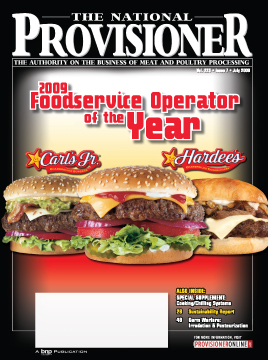
Where other restaurants are thinking small, focusing on value meals and smaller servings, CKE Restaurants is filling in the gap with a large, deluxe, burger-centric menu. Its customer base, largely “young, hungry guys” has come to recognize Carl’s Jr. and Hardee’s as the place to satisfy a craving for a big burger.
Brad Haley, executive vice president for both brands, says that the company’s focus on quality and innovation has turned the restaurants into a premier burger destination.
“We are seeing increased business from guests who are trading down from sit-down restaurants like Applebee’s, Ruby Tuesday’s and Chili’s,” he says. “Customers can feed the entire family for about half the cost of what it would be in a sit-down restaurant.”
Carl’s Jr. was founded by Carl Karcher more than 60 years ago and has grown to more than 1,200 locations throughout the western United States. Hardee’s was founded by Wilbur Hardee in 1960 and has more than 1,900 locations in the Midwest and Southeast. Carl Karcher Enterprises became a wholly owned subsidiary of CKE Restaurants Inc. in 1994. The company acquired the Hardee’s franchise in 1997 and Santa Barbara Restaurant Group Inc. in 2002. With the latter acquisition, CKE added the Green Burrito and Red Burrito restaurant brands to its portfolio. Since then, the company has opened more than 400 dual-branded Carl’s Jr./Green Burrito and Hardee’s/Red Burrito restaurants. CKE Restaurants now has a total of 3,133 licensed, franchised or company-operated restaurants in 42 states and 14 countries.
The company’s focus toward large burgers was solidified with the introduction of the Six Dollar Burger at Carl’s Jr. in 2001 and the Thickburger line at Hardee’s in 2003. The Six-Dollar Burger is so named because the same burger that costs about $3.99 at Carl’s Jr. would cost $6 or more at other casual-dining establishments.
One thing the company has not done to boost sales is to add a cheaper value menu, as many quick-service restaurants have done.
“Other chains are spending more on advertising to tout their 99-cent value menu, but value menus cannibalize sales from the premium menu offerings,” Haley explains. “We are known as the premium-quality brand. We haven’t jumped on the value menu bandwagon for that reason.
“We set ourselves apart from other chains by offering charbroiled, 100-percent Black Angus beef, along with premium toppings such as Portobello mushrooms on our burgers,” he adds.
Rather than trying to compete with the other burger chains, CKE has used its marketing dollars to showcase its value over the casual-dining sector. When it launched the Carl’s Jr. Prime Rib Six Dollar Burger in 2008, it also launched a “Fake Restaurant” ad campaign. The ad showed customers eating what they thought were high-priced burgers from a fancy restaurant that cost anywhere from $14 to $20, only to find they were from Carl’s Jr.
“It wasn’t until after the guests had paid the checks that the truth was revealed to them,” Haley says. “Some were embarrassed, some were surprised, but none were dissatisfied with their purchase.”
A growing menu
CKE’s customer base of young, hungry guys come to Hardee’s and Carl’s Jr. for their large, deluxe burgers, and the company has taken many measures to continue to provide a variety of burger options, sometimes re-introducing past favorites along with new concepts. However, its menu goes beyond burgers. Here is a sampling of new product releases from the company over the last 12 months.
- May 20, 2009: Carl’s Jr. brought back the Portobello Mushroom Six Dollar Menu.
- May 18, 2009: Hardee’s brought back the Six Dollar Thickburger, with a half-pound Angus patty.
- March 18, 2009: Carl’s Jr. offered the Chili Dog, one of the items on the original menu developed by Carl Karcher.
- March 12, 2009: Carl’s Jr. introduced the Kentucky Bourbon Burger, available as a single, double or Six Dollar variety.
- February 23, 2009: Hardee’s added to its breakfast menu with a line of Texas Toast Breakfast Sandwiches, featuring egg, cheese and a choice of bacon, sausage or ham.
- February 18, 2009: Carl’s Jr. introduced a Green Burrito Crisp Burrito, with ground beef, cheddar cheese and jalapenos, rolled into a flour tortilla and deep-fried.
- December 3, 2008: Carl’s Jr. new Charbroiled Steak Sandwich featuring a sirloin steak topped with breaded onion rings, lettuce, tomato and mayonnaise on a toasted steak roll.
- October 29, 2008: The Big Country Breakfast Burrito from Carl’s Jr. included eggs, crumbled bacon and sausage, diced ham, cheddar cheese, hash rounds and sausage gravy in a flour tortilla.
- September 28, 2008: Hardee’s Little Thickburgers, a quarter-pound version of the restaurant’s larger burgers, were made available.
- September 24, 2008: Carl’s Jr. Guacamole Bacon Burger was expanded to include a single and double variety as well as the Six Dollar version.
- September 24, 2008: Hardee’s expanded its breakfast line to include a Pork Chop ‘N’ Gravy Biscuit sandwich.
- July 23, 2008: Carl’s Jr. added the Monster Breakfast Sandwich to its menu, featuring two eggs, two strips of bacon, a sausage patty, Swiss and American cheeses all piled between grilled sourdough bread slices.
Considering the company’s busy schedule, Haley says the R&D team is surprisingly simple.
“Our menu development team is literally just a handful of creative food lovers who continue to come up with innovative hamburgers and other items that our guests love and our competitors copy despite having their own, much larger R&D departments, in some cases with staff numbering in the hundreds,” he says.
The company has also marketed its new products in eye-catching and memorable ways, from commercials that feature bikini-clad women eating their favorite hamburgers to unique partnerships. In re-introducing its Chili Cheese Burgers and Chili Cheese Fries, CKE partnered with the International Drycleaning & Laundry Institute.
“The Institute endorsed the menu items, since guests often visited the dry-cleaners to get the chili stains out of their clothes,” Haley explains. Carl’s Jr. also partnered with the California Avocado Festival to make its new Guacamole Bacon Burger the official burger of the festival. The Festival is located in Carpinteria, home of Carl’s Jr.’s headquarters.
“Becoming the official burger of the festival was a creative approach to promoting the delicious burger,” Haley says.
Surviving the economy
CKE Restaurants has not let the economy slow its growth down.
“For the past two years, CKE Restaurants has put domestic and international unit growth, particularly franchise unit growth, as a priority,” Haley says. For fiscal 2009, which ended on January 26, 2009, the company entered into 20 franchise-development agreements, representing commitments for 380 restaurants (236 domestic and 144 international). The company has agreements to enter into three new countries — China, Pakistan and Kazakhstan.
Haley says that the company’s goal is to add more than 800 new restaurants to its global store base, which would take its number of international locations from 10 percent of the system to approximately 20 percent. Franchised restaurants would expand from 68.5 percent of the system to 75 percent.
CKE is continuing to strengthen its menu to appeal to consumers. The dual-branded concepts of Green Burrito/Carl’s Jr. and Red Burrito/Hardee’s adds authentic Mexican food to the menu, helping to set the company apart.
“Over the last several years, more than 558 restaurants have converted to co-branded restaurants to meet the growing needs of our consumers,” Haley says.
The breakfast menu of Carl’s Jr. is an area where the company has focused. The Monster Breakfast Sandwich and Big Country Breakfast Burrito have helped to fill a need among consumers while again setting the company up as a cost-effective alternative to the casual-dining market.
“Our consumer research revealed that many people felt the typical fast-food breakfast items really didn’t fill them up, so much so that they ordered two sandwiches at a time to get enough food,” Haley says. “While [the Monster Breakfast Sandwich] dwarfs the usual fast-food fare out there, with two eggs, sausage, bacon and cheese, it really is more like the amount of food you would get for breakfast in any diner.”
The company’s focus on sit-down-quality food at non-sit-down prices speaks to today’s consumers, who are increasingly reducing the amount of money they spend eating out but still want to enjoy a quality meal that they didn’t have to prepare themselves. Haley says that those consumers will have a destination that features none of the hassles of sit-down restaurants — “no reservations, no painfully long wait and no tip,” he says. “But you still have a big, delicious burger, served to you at your table.”



Report Abusive Comment